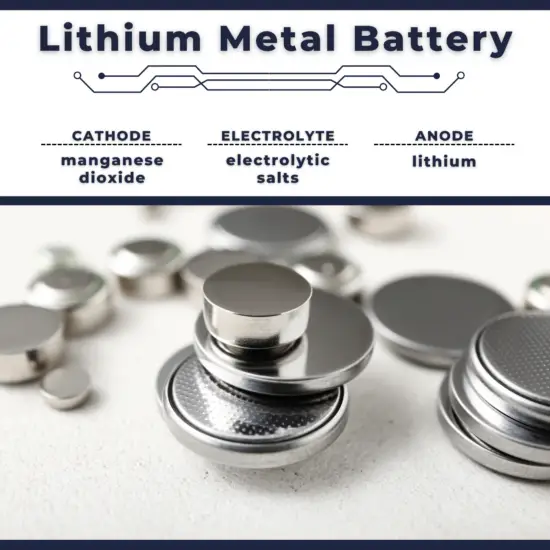30-second summary
Lithium Metal Battery
Lithium-based primary cells are non-rechargeable batteries that have metallic lithium as an anode. These types of batteries are also referred to as lithium-metal batteries.
Primary lithium batteries have the lowest self-discharge rate hence the longest available shelf time, up to 10 years, and in temperatures up to 70.
The most common cells are summarized below:
- Lithium-Manganese Dioxide Cell.
- Lithium Iron Disulphide Cell.
- Lithium Thionyl Chloride Cell.
- Lithium Air Cell.
Overall reaction (Li/MnO2 cells):
Li(s) + MnIVO2(s) ⇌ MnIIIO2(Li+) [E° = +3.19 V]

Lithium Metal Battery
Lithium-based primary cells are batteries that have metallic lithium as an anode. These types of batteries are also referred to as lithium-metal batteries. Note that disposable primary lithium batteries must be distinguished from secondary lithium-ion or lithium-polymer, which are rechargeable batteries. Lithium-ion batteries do not contain metallic lithium.
Primary lithium batteries have the lowest self-discharge rate hence the longest available shelf time, up to 10 years, and in temperatures up to 70. The first letter in the IEC standard system identifies the battery’s chemical composition. C is for lithium metal batteries (as CR2032). The characteristics that make lithium an exceptional electrode material for high energy density batteries include low electrode potential and very high conductivity. It is soft and malleable and can be extruded into thin foils.
They may be classified in several ways, but one convenient method is by the cathode material and voltage. Using an iron disulfide cathode gives a battery with a nominal voltage of 1.5 volts. This cell is used for high-performance AA batteries. Most other lithium batteries are 3.0 volt systems using cathodes comprising either solids (manganese dioxide or carbon monofluoride) or highly toxic liquids (sulfur dioxide or thionyl chloride).
Characteristics of Lithium Metal Batteries
To compare and understand the capability of each battery, some important parameters are characteristic of each battery, also within a type of battery. These parameters are a reference when a battery is needed, and specific qualities are required since batteries are used in all types of devices and for infinite purposes.
Cell Voltage
The voltage of electric batteries is created by the potential difference of the materials that compose the positive and negative electrodes in the electrochemical reaction.
For lithium-manganese dioxide cell, the cell voltage is 3V. Cylindrical lithium iron disulfide batteries (LiFeS2) use lithium for the anode, iron disulfide for the cathode, and a lithium salt in an organic solvent blend as the electrolyte. Designed to be a drop-in replacement for Zinc-carbon or alkaline batteries, the cell voltage is 1.5 volts.
Cut-off Voltage
The cut-off voltage is the minimum allowable voltage. It is this voltage that generally defines the “empty” state of the battery.
The nominal voltage of the CR2032 battery is 3.0 V and the cutoff voltage is 2.0 V.
Capacity
The coulometric capacity is the total Amp-hours available when the battery is discharged at a certain discharge current from 100% SOC to the cut-off voltage.
The CR2032 battery has a typical capacity in the 210-230 mAh range.
C-rate of Battery
C-rate is used to express how fast a battery is discharged or charged relative to its maximum capacity. It has units h−1. A 1C rate means that the discharge current will discharge the entire battery in 1 hour.
Self-discharge
Batteries gradually self-discharge even if not connected and delivering current. This is due to non-current-producing “side” chemical reactions that occur within the cell even when no load is applied.
The annual self-discharge rate of CR2032 battery at room temperature and normal humidity is less than 1% of the nominal capacity.






